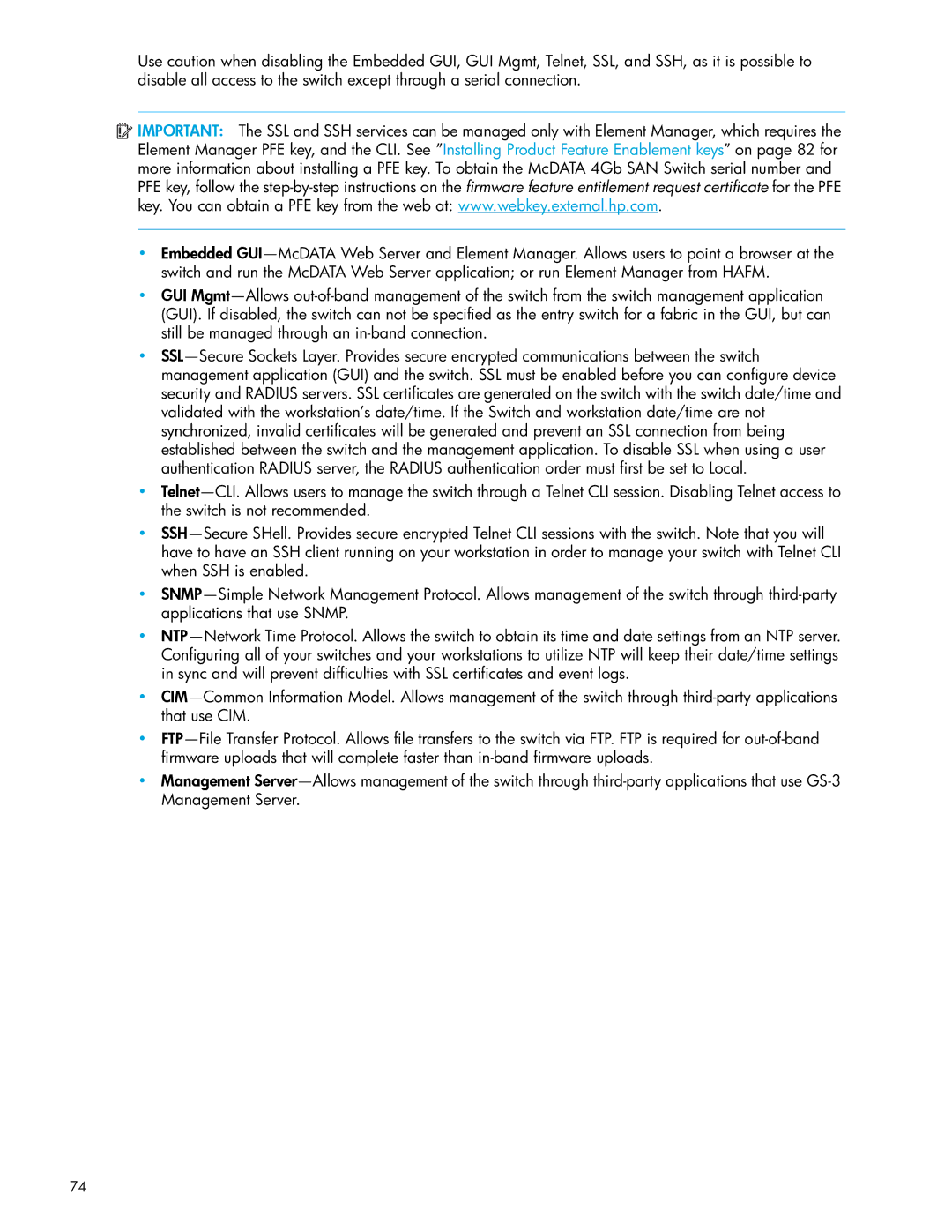Use caution when disabling the Embedded GUI, GUI Mgmt, Telnet, SSL, and SSH, as it is possible to disable all access to the switch except through a serial connection.
 IMPORTANT: The SSL and SSH services can be managed only with Element Manager, which requires the Element Manager PFE key, and the CLI. See ”Installing Product Feature Enablement keys” on page 82 for more information about installing a PFE key. To obtain the McDATA 4Gb SAN Switch serial number and PFE key, follow the step-by-step instructions on the firmware feature entitlement request certificate for the PFE key. You can obtain a PFE key from the web at: www.webkey.external.hp.com.
IMPORTANT: The SSL and SSH services can be managed only with Element Manager, which requires the Element Manager PFE key, and the CLI. See ”Installing Product Feature Enablement keys” on page 82 for more information about installing a PFE key. To obtain the McDATA 4Gb SAN Switch serial number and PFE key, follow the step-by-step instructions on the firmware feature entitlement request certificate for the PFE key. You can obtain a PFE key from the web at: www.webkey.external.hp.com.
•Embedded GUI—McDATA Web Server and Element Manager. Allows users to point a browser at the switch and run the McDATA Web Server application; or run Element Manager from HAFM.
•GUI Mgmt—Allows out-of-band management of the switch from the switch management application (GUI). If disabled, the switch can not be specified as the entry switch for a fabric in the GUI, but can still be managed through an in-band connection.
•SSL—Secure Sockets Layer. Provides secure encrypted communications between the switch management application (GUI) and the switch. SSL must be enabled before you can configure device security and RADIUS servers. SSL certificates are generated on the switch with the switch date/time and validated with the workstation’s date/time. If the Switch and workstation date/time are not synchronized, invalid certificates will be generated and prevent an SSL connection from being established between the switch and the management application. To disable SSL when using a user authentication RADIUS server, the RADIUS authentication order must first be set to Local.
•Telnet—CLI. Allows users to manage the switch through a Telnet CLI session. Disabling Telnet access to the switch is not recommended.
•SSH—Secure SHell. Provides secure encrypted Telnet CLI sessions with the switch. Note that you will have to have an SSH client running on your workstation in order to manage your switch with Telnet CLI when SSH is enabled.
•SNMP—Simple Network Management Protocol. Allows management of the switch through third-party applications that use SNMP.
•NTP—Network Time Protocol. Allows the switch to obtain its time and date settings from an NTP server. Configuring all of your switches and your workstations to utilize NTP will keep their date/time settings in sync and will prevent difficulties with SSL certificates and event logs.
•CIM—Common Information Model. Allows management of the switch through third-party applications that use CIM.
•FTP—File Transfer Protocol. Allows file transfers to the switch via FTP. FTP is required for out-of-band firmware uploads that will complete faster than in-band firmware uploads.
•Management Server—Allows management of the switch through third-party applications that use GS-3 Management Server.

![]() IMPORTANT: The SSL and SSH services can be managed only with Element Manager, which requires the Element Manager PFE key, and the CLI. See ”Installing Product Feature Enablement keys” on page 82 for more information about installing a PFE key. To obtain the McDATA 4Gb SAN Switch serial number and PFE key, follow the
IMPORTANT: The SSL and SSH services can be managed only with Element Manager, which requires the Element Manager PFE key, and the CLI. See ”Installing Product Feature Enablement keys” on page 82 for more information about installing a PFE key. To obtain the McDATA 4Gb SAN Switch serial number and PFE key, follow the 